Posted by Elena del Valle on April 11, 2014
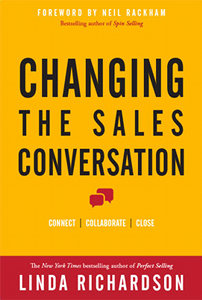
Changing the Sales Conversation
Photos: Sharon Wolmuth
As the market has shifted with social media and technological advances so have consumers. Selling requires a new approach and an increased awareness of client needs and likes, according to some experts. In Changing the Sales Conversation: Connect, Collaborate, and Close (McGraw Hill, $22) Linda Richardson, founder, Richardson, a sales performance company, discusses the issues she considers relevant to the changing sales environment for a target audience of salespeople and sales managers primarily in business to business sales.
”
I introduced Consultative Selling several decades ago and while the tenants of Consultative Selling remain relevant, buyers’ buying habits have dramatically changed and I wrote Changing the Sales Conversation to extend the concepts of
Consultative Selling to foster a new dynamic dialogue for the new sales landscape. The internet and emerging technologies have changed the face of selling so much so that many of the tried and true sales methodologies of just a short time ago are obsolete and some can actually hurt sales,” she said by email in response to a question on why she wrote a book about sales.
The 162-page hardcover book was published this year. It is divided into: Introduction, Futuring: Meta-Preparation, Heat-Mapping: Anticipating Client Need, Value-Tracking: Shaping Solutions, Phasing: Controlling the Process, Linking: Connecting Emotionally, and Opening into the Future. The author explained she wrote it to provide insight into the changes and give models and tools to help salespeople and sales managers succeed in the new world of selling.
”
The key to selling to customers today is to insure that they have a higher level of expertise and skill and having access to resources, research, and tools. Salespeople must have industry, company, and stakeholder knowledge and use tools and research to understand the individuals they are selling to including their cultures and values. I cover this in the chapter on Futuring which is a higher level of preparation. Sales organizations must support salespeople with knowledge sharing, training, and tools,” Richardson said in reply to a question about dealing with diversity in an increasingly global marketplace when trying to build trust.

Linda Richardson, author, Changing the Sales Conversation
“One of the key challenges is to get ahead of the opportunity by brin(g)ing ideas to customers. It is important for salespeople to understand what their clients already know because clients are doing research, using social media, and turning to peers and can be half way through the buying cycle before talking to a salesperson. The real challenge I see is having the knowledge and insight to bring ideas to clients rather than get involved late in the sale when the client is advanced and be in heavy competition,” she said in response to a question about the biggest challenge in getting to know a client in today’s environment.
The consultant believes clients expect sales people to be prepared and informed. In the book, she explains that clients are able to tell quickly whether a salesperson is able to create value for them, and that by being informed about a client’s industry, company and stakeholders a salesperson will be competitive. Using tools such as social media, paying attention to their client’s trusted sources and listening to clients to learn about their needs and environment can be important in increasing productivity; and preparing in advance is necessary to succeed, she says.
Richardson teaches sales and management at the Wharton Graduate School of the University of Pennsylvania and the Wharton Executive Development Center. Her previous book, Perfect Selling, was a The New York Times bestseller.
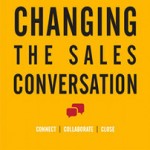
Click to buy Changing the Sales Conversation
Comments:
Filed Under: Books
Posted by Elena del Valle on April 2, 2014
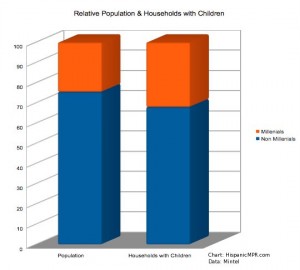
2014 Relative Population & Households with Children – click to enlarge
In the United States, two thirds of Millennials have never been married, according to Marketing to Millennials US February 2014 Executive Summary, a Mintel report. Those who got hitched are in their late twenties. The median age for first marriage is about 29 for men and 27 for women. Thirty-two percent of households with children are Millenial households. At the same time, 43 percent of Millenial households include children.
Although 25 percent of Millenials 25 and older have a bachelor’s degree and 9.5 percent have a graduate degree compared to 11.1 percent of all adults, unemployment among that market segment is higher than for the national average. At the time of the report, 10.3 percent of Millennials between 20 and 24 years old, and 6.8 percent of Millennials aged between 25 and 34 were unemployed. The national unemployment average is 6.5 percent.
There’s a notable difference in household income between younger and older Millenials. While Younger Millennials, those under 25 years of age, have a median household income of $30,604, the median income of Older Millennials, those 25 and older, is about $51,381. The former may be still be studying or in an entry-level job, whereas Older Millennials may be working full-time and more advanced in their career. Mintel researchers believe the 2008 financial crisis caused median income for those aged 15-24 to decline 13 percent between 2007 and 2012, and decline 9 percent for adults aged 25-34.
At the same time, annual spending for Younger Millennials is 40 percent less than for all adults, while among Older Millennials, average expenditures are about 4 percent less. Younger members of the market segment spend less on everything except education. Older Millennials spend a good deal more than all adults on alcoholic beverages and apparel and services, and significantly less on healthcare.
Posted by Elena del Valle on March 28, 2014
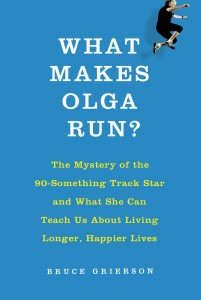
What Makes Olga Run
Photos: Jennifer Williams, Henry Holt and Company
Geriatric runners have become a common site in urban marathons but ninety year old sprinters are exceptional, says Bruce Grierson. In What Makes Olga Run The Mystery of the 90-Something Track Star and What She Can Teach Us About Living Longer, Happier Lives (Henry Holt and Company, $25), the author explores what makes Olga Kotelko, a 91 year old sprinter who held 26 world records in 2009, exceptional.
At five feet and half an inch tall and weighing 130 pounds she is, he explains, extraordinarily strong. As of the publication of the book this year she was the holder of 600 medals.
“I think two types of readers are in the sweet spot:
The first are people who’ve been lifelong exercisers who are now suddenly burning out or breaking down or both. Having to figure out how to mix things up so as to mitigate the damage and rekindle the interest.
The second group is middle-aged couch potatoes. Their takeaway message is that it’s never too late,” he said by email in response to a question about the target audience for the book. “The science is telling us that you can make massive gains even deep into life. The trick is to get started. It’s hard to start. Olga says that a lot: ‘Don’t stop, cuz it’s hard to get started again.'”
The 231-page softcover book is divided into Prologue, Coda and 12 chapters. In addition to Kotelko, Grierson interviewed dozens of masters athletes and closes the book with nine tips for readers who want to emulate the high performing older athletes.

Bruce Grierson, author, What Makes Olga Run?
When asked what the hardest part of the book project was he said: “Getting the running shorts over my pot belly. No, seriously, the difficult part was trying to run a narrative through the all the science without getting bogged down in detail but still getting the facts right. The physiology of aging is a fascinating area that’s changing almost by the day. A challenge to stay on top of.”
The most rewarding or surprising aspect? “Getting to know Olga as a person, not just as a scientific anomaly or a story ‘subject.’ We spent a lot of time together. It helped that we were simpatico. She’s taught me a lot, and most of it has nothing to do with ‘fitness,’ per se.”
Asked if there was third party funding or sponsorships for the book project he said: ”
No. The scientists involved did the testing for free. In McGill’s case, the scientists specifically got their own funding to conduct the muscle physiology tests on Olga, as part of an ongoing investigation on aging athletes. The small stuff I paid for. Olga got the guinea pig’s discount (i.e. free).”
Grierson, a freelance writer, is author of U-Turn: What If You Woke Up One Morning and Realized You Were Living the Wrong Life? He lives in North Vancouver, Canada.

Click to buy What Makes Olga Run?
Comments:
Filed Under: Books
Posted by Elena del Valle on March 20, 2014
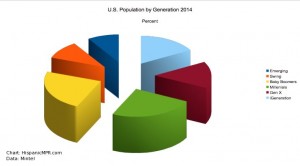
U.S. Population by Generation Percent – 2014 – click to enlarge image
In 2014, there were 78.3 million Americans aged 20 to 37. This market segment, often described as Millennials, represents a quarter of the country’s population. Almost one in five (19.4 percent) Millennials is Hispanic, 14.8 percent is Black, and 5.2 percent is Asian, making the group among the most diverse, according to Marketing to Millennials US February 2014 Executive Summary, a Mintel report.
While Baby Boomers protect their private data, 60 percent of Millennials who responded to Mintel questions said they would be willing to provide details about their personal preferences and habits to marketers. Even for private information these young adults are open minded. Among respondents to the Mintel questions, 30 percent of Millennials said they would share personal information in exchange for a financial incentive such as a $10 discount. Only 13 percent of Baby Boomers who answered the question said they would be willing to do the same.
“Millennials are predisposed to share their personal habits and contact information with marketers, but they do so only when the perceived benefits outweigh the risks. Given that their generation accounts for nearly a quarter of the population, the implications for businesses are tremendous, because as Millennials go, so goes the US economy,” said Fiona O’Donnell, category manager, retail, multicultural, lifestyles and leisure, Mintel, in a press release.
Millennials said they are more likely to share cell numbers and social media profiles with companies than Baby Boomers (30 percent compared to 14 percent and 27 percent compared to 10 percent, respectively). Baby Boomers said they were more willing to share a mailing address, 40 percent versus 38 percent of Millennials. For the most private information, credit scores, 17 percent of Millennials and 8 percent of Baby Boomers were willing to provide the information.
The generational groups represented in the Mintel report are Baby Boomers (23.6 percent), Emerging (9 percent), Gen-X (15.4 percent), iGeneration (16.9 percent), Millenials, Swing (10.5 percent). Baby Boomers are aged 50 to 68, Emerging are under seven years old, Gen-X is 38 to 49, iGeneration is seven to 19, and Swing are 69 and older.
Posted by Elena del Valle on March 14, 2014
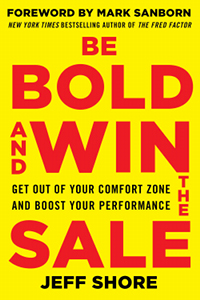
Be Bold and Win the Sale
Photos: McGraw Hill, Jeff Shore
Taking action despite fear and discomfort without being manipulative or obnoxious when others would back away is what Jeff Shore advises when it comes to sales. In Be Bold and Win the Sale Get Out of Your Comfort Zone and Boost Your Performance (McGraw Hill, $20) he emphasizes that winning should reward all parties involved, and that a sale is about helping customers improve their lives.
At the end of the chapters, he features Expert Interviews in which he illustrates the point of that chapter with feedback or quotes from someone he considers an expert. For example, in the chapter on discomfort he quotes Daniel Pink, author of Drive: The Surprising Truth About What Motivates Us. Pink points to a study from the University of Pennsylvania that suggests the best sales people are neither completely introverted nor extroverted but rather in the middle of the spectrum.
He also recommends finding experts who stand out when it comes to picking up and understanding the perspectives of others. Serving, by improving someone’s life, Pink believes, is lacking the most in today’s sales world.
The 261-page softcover book published this year is divided into three parts and 15 chapters. Part One, Dealing with Discomfort, features: “Well, This is Awkward,” Getting Your Inner Boldness On, That Nagging Squirminess, Story Time, and The Gut Check.
Part Two, Developing Boldness, features: Let’s Do This Thing!, The Boldness Network, Retraining Your Brain, Big Problems in Little Packages, Handling the “Gotchas,” The Advanced Course, and Go! Part Three, Putting It All to Work, features: The Customer’s Mission, The Customer’s Mission, The Customer’s Mission, and Putting It All Together.

Jeff Shore, author, Be Bold and Win the Sale
Shore, founder and president, Shore Consulting, Inc., is fellow of the National Speakers Association’s Million Dollar Roundtable.

Click to buy Be Bold and Win the Sale
Comments:
Filed Under: Books
Posted by Elena del Valle on March 6, 2014

Bear Grylls
Video, photos: Discovery en Español
Targeting an adult audience between 25 and 49 years of age Discovery en Español will release the six-part series Bear Grylls: Escape from Hell (Escape del Infierno con Bear Grylls) as part of a new programming block dedicated to human adventure and survival shows Thursday nights. The programs will be dubbed into Spanish from the original English language production. The first 60-minute segment will air at 9 p.m. ET/PT March 6, 2014 and the final episode will air April 9 of the same year. Scroll down to watch a promotional video in Spanish.
According to a press release, Escape del Infierno con Bear Grylls reveals true stories and first person accounts of people who escaped death in some of the most desolate and hostile places on the planet. Each episode presents three real life incidents in places such as the heart of the Amazon Jungle or California’s Sierra Nevada. Grylls traces back the steps taken by survivors, analyzing their life-saving techniques, mistakes made, and the ways they could have adverted danger.

A scene from Vivir para Contarlo
Some of the stories described in the program include: Eric Le Marque, who endured eight days in below zero temperatures in California’s Sierra Nevada. Even after falling in the freezing waters of a river, he kept walking until he was rescued; the French explorers Loic Pillois y Guilhem Nayral, who each lost more than 45 pounds after roaming the heart of Amazon for seven weeks; Polish natives Maciej Tarasin end Tomek Jedrys, who became lost in the Raudal del Tiburon Canyon in Colombia; Italy’s Mauro Prosperi, a contestant in a race in the Sahara Desert who went astray and had to face the highest temperatures on the planet for nine days without water.
The Bear Grylls series, produced by betty (an English production house owned by Discovery Communications Inc.) for Discovery Networks International in English, was completed and aired in the United States and abroad in 2013. Sarah T Davies is executive producer for Discovery Networks International. Neil Smith is the executive producer for betty.

A scene from Supervivencia – click to enlarge
Other survival shows to be featured as part of the Thursday night block include a new season of Vivir para Contarlo Thursdays at 8 p.m. ET/PT. The original series highlights stories from Latin America. A weekly program Supervivencia al Desnudo will air Thursdays at 10 p.m.ET/PT. It will showcases a new pair of total strangers, one man and one woman, stranded in and exposed to some of the world’s most extreme weather environments in a remote location, for 21 days, without food, water, or clothing.
Posted by Elena del Valle on March 4, 2014
Information provided by Event Partner

14th Annual Multicultural Media for Multicultural America Forum
Horowitz Associates’ 14th Annual Multicultural Media for Multicultural America Forum
March 20, 2014 | Edison Ballroom, NYC
8:00am – 5:30pm
The Multicultural Media Forum is a unique, research and strategy-driven event attended yearly by roughly 400 executives and decision-makers from the media, advertising, technology, and financial industries. Originally conceived as a summit to call the industry’s attention to the then-untapped value of multicultural consumers to businesses across the media spectrum, the Forum was the first and remains the leading event focused on the media consumption behaviors, attitudes, and demands of America’s diverse “new general market.” The theme of this year’s event is Transcending Multiculturalsim.
Our aim through this year’s Multicultural Media Forum is to lead the media industry beyond its conventional understanding of “multiculturalism” and toward a new paradigm of “transculturalism” that encompasses and weaves together America’s myriad cultures into a new vision of the mainstream that truly reflects our country’s vibrant diversity. What exactly is transculturalism? How is it different from other words that are being used of late—words like multicultural, total-market or cross-cultural? Perhaps most importantly, what are the implications of this idea of transculturalism to all aspects of the media industry? Whether your business is aimed towards the “general market,” Millennials, or whether you target distinct multicultural segments, understanding the implications of transculturalism will be critical for your future success.
The agenda will include a research presentation featuring new research on Hispanic and multicultural consumers and their media habits. The agenda will also include a case study from sesame workshop entitled “Lessons from the Street: What Sesame Workshop Learned from Hispanic Moms and Kids.” Learn more about this new concept and the future of the media industry at this March 20th event.
Confirmed speakers and panelists include:
-
Julio Arrieta, Managing Director, Brand Leadership, Lopez Negrete
-
Clayton Banks, President, Ember Media
-
Artie Bulgrin, SVP, Research & Analytics, ESPN
-
Silvina Cendra, Planning Director, Grupo Gallegos
-
Marve Frazier, Chief Creative Officer, Moguldom Media
-
Joel Kliksberg, VP and Chief Strategy Officer, Fusion
-
Michael Maliner, VP, Strategic Planning, UniWorld Group
-
Evan Shapiro, President, Pivot
Radha Subramanyam, EVP, Sales and Marketing Research, Clear Channel Media and Entertainment
-
Luba Tolkachyov, Co-Founder and Managing Partner, Findr Group
-
José Vélez-Silva, Senior Director, Multicultural Marketing, Comcast
-
José Villa, President, Sensis
For the full list of speakers: www.multiculturalmediaforum.com
The Multicultural Media Forum will take place on Thursday March 20th, 2014 at the Edison Ballroom in New York City from 8:00a.m.-5:30 p.m. Visit www.multiculturalmediaforum.com for more information and to register.
Enter promotional code HMPR2014 and receive an extra $50 off!
For more information and sponsorship opportunities, please contact us at 914-834-5999 or stephaniew@horowitzassociates.com.
Posted by Elena del Valle on February 28, 2014
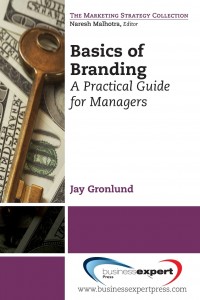
Basics of Branding
Photos: The Pathfinder Group
Not all brands are created equally. Some pass unnoticed and fade into oblivion while others linger in our minds for years or longer. What makes the difference? Powerful brands are different, compelling, and relevant enough to truly excite the minds and hearts — and wallets — of their customers. That is what Jay Gronlund, a business development consultant, believes. In his new book Basics of Branding: A Practical Guide for Managers (Business Expert Press, $43.95) he explains how readers can create an emotional connection with their customers that results in sustainable brand loyalty and steady revenue growth. The book is also available in digital format for $19.95.
“Yes, definitely. The principles behind branding are relevant for all types of businesses, big or small, product or service,” Gronlund said by email in response to a question about the relevance of branding regardless of size of the company. “Brand positioning starts with defining and thoroughly understanding your target customer. Most start-ups are preoccupied with their new product or service, and don’t pay enough attention to addressing what their potential customers want, especially from an emotional standpoint. Branding is basically about creating a relationship with a customer, and it has been proven by neuroscientists that emotions have the most influence on human behavior, including purchase decisions.”
The 194-page softcover book with tables and illustrations published in 2013 is divided into six chapters: What Is Branding Really About?; The Positioning Statement, Emotions and Brand Equity; Branding Applications; Building Strong Bonds; Branding in the B2B World, New Opportunities; Marketing Today: Branding for Digital Marketing and Social Media. Gronlund proposes that it is critical to begin with a “message or impression that forges a bond of trust with that customer.”
One thing to remember about branding? “Branding is all about forming a connection with your customer, ideally one based on experience and emotions that make that customer trust that brand,” he said by email.

Jay Gronlund, author, Basics of Branding
When asked about developing a brand for an intangible such as an author he said: “A service, while not as concrete as a product, still requires good branding, since both must make a promise (i.e. the benefit) to a target audience, supported by credible reasons to believe this promise. Ultimately, a customer will become interested in a service, and buy it, only if they feel emotionally (and rationally) that such a service will add some value to their lives and make them more happy and satisfied. Any author, for fiction or non-fiction, should try to brand him or herself, so that the author’s (brand) name will mean something special to prospective readers. Ideally building a bond with his/her audience is based on trust, plus the expectation that each time he/she will learn and/or be entertained. The brand impression the author provides should be distinct, relevant and tailored to the unique characteristics of his/her storytelling, content/subject matter, and flair for offering something new and creative.”
Gronlund has held senior positions at Richardson-Vicks, Church & Dwight, Seagrams, and Newsweek. In 1990, he started The Pathfinder Group, a boutique business development consulting firm specializing in cross-border marketing; re-positioning brands; facilitating ideation sessions; and con- ducting workshops overseas. In 1999, he created a course on positioning and brand development for New York University he still teaches today.

Click to buy Basics of Branding
Comments:
Filed Under: Books
Posted by Elena del Valle on February 27, 2014
Information provided by Event Partner
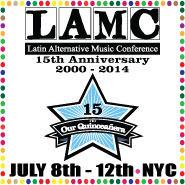
Latin Alternative Music Conference, New York City July 8-12, 2014http://www.latinalternative.com/
The LAMC (Latin Alternative Music Conference) is the only major conference celebrating and supporting genres of Latin music that are left of center and forging the way Latinos, especially young, bicultural Latinos in the U.S., define themselves. Hailed by The New York Times as the “Sundance of Latin music”, the LAMC is also the largest Latin music conference in the US.
The 15th annual LAMC will break new ground, inaugurating a new, expanded focus on a diverse array of special events dedicated to music, food, film, books, art and poetry.
Posted by Elena del Valle on February 20, 2014

Hercules before Operation Lion Ark – click image to enlarge
Video, photos: Animal Defenders International (ADI)
Animal Defenders International (ADI), a 501(c)(3) nonprofit organization registered in Delaware and California, with offices in Los Angeles, London and Bogota, campaigns on behalf of animals used in entertainment, and other industries. Recently, the organization relocated circus animals, including 29 lions, from circuses in Bolivia after that country’s legislature passed a new law banning animals in traveling circuses, and asked ADI for assistance relocating the lions abroad.
According to ADI, Bolivia’s ban on animals in traveling circuses was the result of the organization’s undercover investigation that exposed behind the scenes cruelty, and its public education campaign. While one circus surrendered the lions voluntarily eight others weren’t ready to comply initially. ADI, with the support of government representatives, pressured the circuses into turning the remaining lions into their custody.
During Operation Lion Ark in 2011, in addition to the lion seizures, the team assisted in moving six monkeys, a coati mundi, a deer and a horse. The native wild animals (monkeys, coati mundi and deer) were returned to protected wild areas.
“What I didn’t realize was that it was going to be an extraordinary story about the human spirit and what the human spirit can do when people come together,” said Jorja Fox, an actress known for her role as Sara Sidle in television show CSI who was an associate producer of Lion Ark and also appears in the film, in a press release.

Hercules after Operation Lion Ark – click image to enlarge
There were about twenty people in the ADI team that saw to the rescue and relocation of the circus animals. They were from Britain, Bolivia, Colombia, Peru and the United States. The organization filmed the activities that took place during the seven month period in which 25 of the 29 lions were seized from the circuses, rehabilitated, flown to their new home in Colorado and released in their new habitat. The result was Lion Ark, a moving film that covers the process from the ADI perspective and features interviews with investigators, campaigners, government officials and members of congress in Bolivia.
The film was separate from the relocation project and took about two and half years to complete. Scroll down to watch short video clip of Lion Ark film.
The relocation of the animals, ground and air transport, crates and the building of the animal enclosures and lion houses at sanctuaries the United States cost over a million dollars. The film budget itself was separately funded, and was about half a million dollars. Bob Barker, a well known celebrity in the United States and an animal rights advocate, funded Operation Lion Ark.
In order to provide the lion prides an experience as close as possible to what they might have had in a natural environment, they were placed in four natural enclosures (among the largest available) occupying 80 acres at The Wild Animal Sanctuary (TWAS) near Denver, Colorado.
“People sometimes ask, why bother about animals when there’s so much human suffering? But it is not a choice of one or the other. When we protect the weakest or the most vulnerable, whether it is animals or people, we all gain. That’s how we shape our world…understanding our connection with other species, and our place on this planet, is the next step in human evolution,” said Jan Creamer, president and founder, Animal Defenders International, in the film.
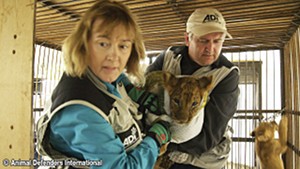
Jan Creamer and Tim Phillips of ADI and a lion cub
Since their relocation, the Lion Ark lions have been living in family prides at the Colorado facility where ADI plans to continue to fund their care for the rest of their lives, according to ADI. The new lion home was outfitted with fencing and basic safety measures as well as enrichment facilities, wooden constructions to climb and play on, hill-like mounds and underground dens, to provide a diverse and exciting space to keep the lions busy and stimulated.
Lion Ark, the film, was nominated for this year’s Image Awards of the National Association for the Advancement of Colored People (NAACP) in the Outstanding International Motion Picture category. The other five nominees in the that category are: War Witch; Call Me Kuchu; La Playa D.C.; and High Tech, Low Life.
Lion Ark Film Festival Selections include: Winner Best Documentary (Jury Award), Sun & Sand Film & Music Festival, Mississippi; Winner Audience Choice Best Documentary, San Diego Film Festival; Audience Choice Award Anchorage International Film Festival; Official Selection Raindance Film Festival, London; Official Selection Mill Valley Film Festival; Official Selection Hawaii International Film Festival; Official Selection Fort Lauderdale International Film Festival; Official Selection Virginia Film Festival; Official Selection Starz Denver Film Festival; Official Selection Irvine International Film Festival; Official Selection Beloit International Film Festival; Official Selection Sedona International Film Festival.
“We are honored to have been nominated for this award. Lion Ark is a film about respect for people and animals so we are really pleased to receive this acknowledgement,” said Tim Phillips, director, Lion Ark, in a press release. “In this film, you see the worst of humanity, but also humanity at its best. It is an empowering film that shows that people can make a difference. Lion Ark shows how animal protection is a vital part of the fabric of social justice, where human society draws a line as to what is, and is not, acceptable.”
The producers of Lion Ark hope to have the movie on general release in 2014. Once Lion Ark is purchased by movie distributors, it should become available at movie theaters, and via TV, DVD and VOD, a representative explained by email. As of November 10, 2013, Lion Ark had appeared in eight major film festivals in United States and United Kingdom.
http://www.ad-international.org/adi_usa/ (required by Animal Defenders International)































